The New Year destination is now looking to up its fort restoration to attract tourists not just to its beaches, but the stone marvels too
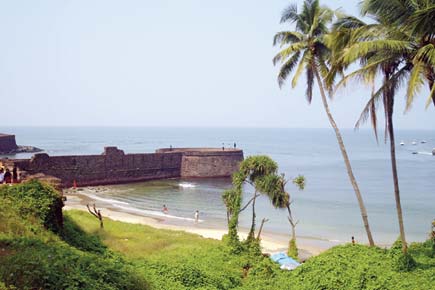
One of the great obsessions of the late cartoonist Mario Miranda, was to restore and conserve a fort in his native Goa. For around two decades he doggedly pursued the matter through INTACH (Indian National Trust for Art and Cultural Heritage, Mario was the convener of INTACH), the Goa government, and all others concerned, even arranging the required funds through the Helen Hamilton Trust in the UK to restore one of Goa’s most picturesque forts, the Reis Magos Fort, located at a vantage point on the Mandovi river bank facing the capital city Panjim.
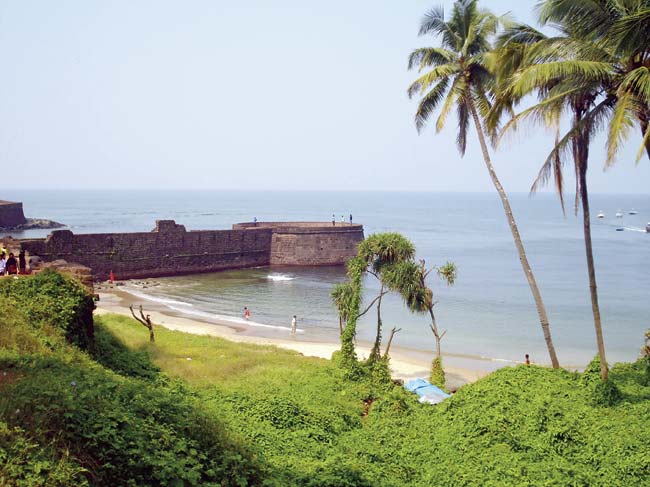
A pier of the Aguada Fort at Sinquerim Beach in Candolim is a vista of green and blue , sugar and spice and everything nice
The fort which had fallen into disrepair was finally restored over a period of years, by conservation architect Gerard D’Cunha and reopened to the public a couple of years ago. Unfortunately, the cartoonist died a few months before the fort could reopen. But guess what? The citadel now houses a museum dedicated to the early art works and cartoons of Mario Miranda.
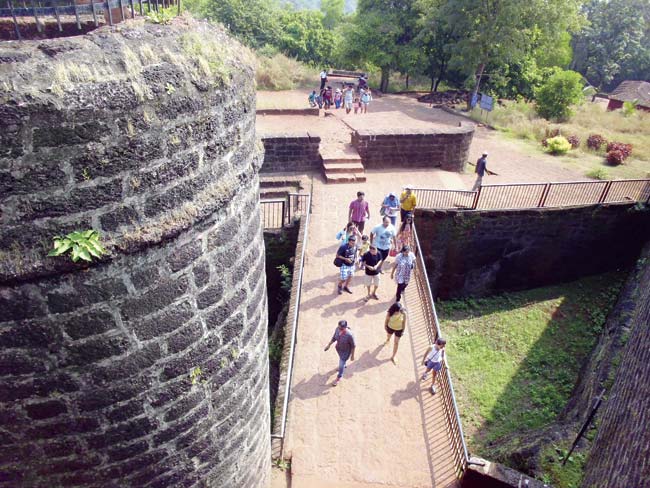
Goa’s forts draw a large number of tourists every year
Old is gold
It is the oldest fort in Goa, first built around 1493 by the Adil Shah of Bijapur, and subsequently rebuilt by the Portuguese in 1551 to protect the old city of Goa capital of the Portuguese empire in Asia further upstream on the Mandovi River. It is located at the narrowest part of the river. Reis Magos means ‘three kings’ in Portuguese, and the place gets its name from the adjacent church dedicated to the three kings who visited the infant Jesus.
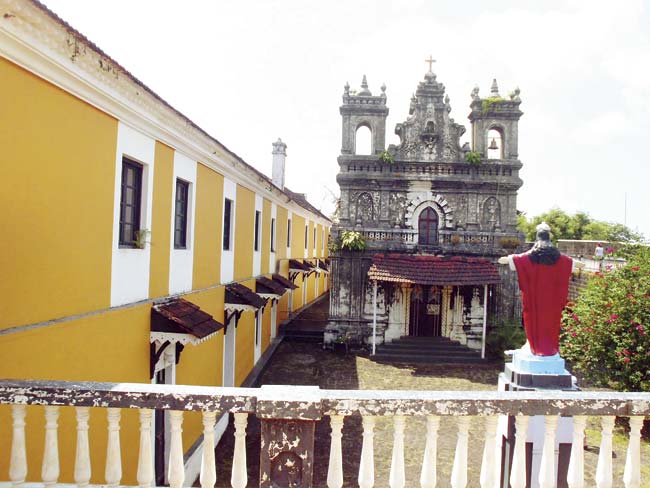
St Anthony's chapel inside Tiracol Fort
In the old days, new Portuguese governors arriving in Goa would disembark there and stay till the old governor would leave, and then ceremonially enter the city of Goa (present day Old Goa). In the early part of the 20th century the fort was used as a prison, a hospital and finally abandoned in 1993, only to be ‘relaunched’ after conservation work in 2012 to ‘serve as a cultural and heritage centre’.
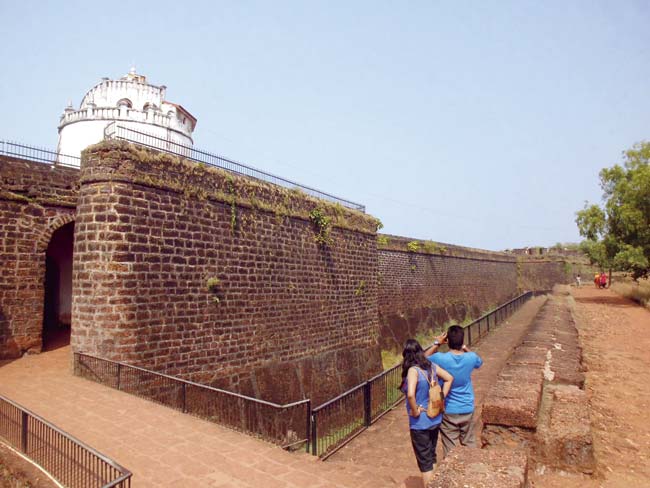
Aguada Fort is Goa’s most famous fort
The tiny fort at St Estavem, near Old Goa, was also restored in recent years, though being a bit out of the way in a remote village which once formed the eastern boundary of the ‘Old Conquest’ areas of the Portuguese era it has not yet become a part of the tourist circuit.
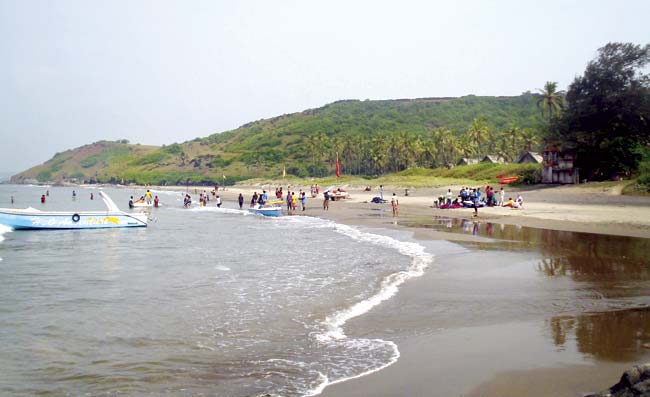
Vagator Beach with the Chapora Fort on the hill behind
Though most of them have been abandoned and are now in ruins, Goa’s 14 (approximately) forts are a big draw with tourists, historians, Bollywood and other regional cinemas because of their amazing locations and stunning vistas. Most of them are on the Konkan coast, strategically located at the mouths of rivers to block any intruders.
The biggest of them all is the Aguada Fort in Candolim, which encompasses a whole mountain. Thousands of tourists visit it every day. Built by the Portuguese in 1613 to guard against the Dutch and Marathas, it gets its name from the Portuguese word for water agua, the water store.
There is a huge underground water storage chamber which can store 2,376,000 gallons of water (the biggest such facility in Asia in those days), and in the old days was visited by ships for replenishing their fresh water. It once had 79 cannons and a lighthouse. Like with forts in mystery novels, it apparently also has a secret escape passage to use during times of war and emergency.
Part of it is now used as a prison, the plateau around has a helipad, and the spectacular Vivanta by Taj Fort Aguada Resort is located within the ramparts on the sea-facing western side. The helipad has been used for many big music shows, but a plan to build an amusement park has been blocked by some land-owners who originally owned the land.
Down south
Except for the Cabo de Rama Fort in south Goa whose ramparts also encompass a mountain and which is now in ruins, most of the other forts are tiny, and were acquired from the Marathas by the Portuguese through conquests. The prettiest of them all is probably the tiny Tiracol Fort on the Goa-Maharashtra border on the Konkan coast. Perched atop a high mountain, it has sweeping views of the sea, the shores and the river upstream.
Until a few months ago, it was used as a boutique hotel by Moonrise Tourism. It is now undergoing maintenance and restoration work at a cost of R 4-crore and will then be turned into a venue for events like exclusive weddings, according to the Goa Tourism Development Corporation (GTDC), to coincide with the Goa Tourism Department’s ‘Wedding Destination’ theme this year.
“It can also be hired out to host music festivals, heritage and cultural activities,” a senior GTDC official said. “We have engaged the services of Pune-based consultant to chalk out plans for its beautification.” The idea is to make the forts self-sustaining. “Money generated will be used for future maintenance of the fort and beautifying the area around it.
We are also contemplating setting up a permanent sound and light show depicting the history of the fort to visitors,” says GTDC chairman Nilesh Cabral, an MLA of the ruling BJP government. Goa’s Tourism Minister Dilip Parulekar says the Tiracol Fort, though small, has vast land holdings on the seaward side.
Being located at the extreme northern tip of the 105-km-long Goan coastline, it is only visited by a trickle of tourists, which gives it a more ‘exclusive’ air. Entry for general visitors is also limited to certain areas, and only resident guests can go down to what is probably by accident, the only private beach in Goa, because it is otherwise inaccessible.
Says Parulekar, “There is vast land there, so without disturbing the fort’s structure or the CRZ (Coastal Regulation Zone) norms, and using eco-friendly material like wood, we are going to build a wedding centre there, and Goa Tourism’s ‘Wedding Destination’ theme will be launched there.
We also have plans to develop other forts like the ones at Alorna and Corjuvem. But it is a tedious process as the forts come under the Archeological Survey of India (ASI) which comes under the Central government, and getting permissions is a long process. We managed to do the Reis Magos Fort, and we’re hoping that the other forts too can be restored and readapted for tourism-related activities.” So if you’re looking for a historic location for your nuptials, you know where to go.
History’s pages
In 1825, Dr Bernado Peres da Silva, the first Goan born Viceroy of Goa, used the fort as a base for an armed rebellion against the Portuguese. It failed, and he had to flee Goa. During the late Portuguese era, the Tiracol Fort, because of its remoteness, was used as a prison to jail Goan freedom fighters.
Many Goan forts have featured in Bollywood and other regional cinema. The Aguada Fort was featured in Singham. Most famously the sprawling Chapora Fort had a prominent role in the mid-’90s film Dil Chahta Hai. The name is the Portuguese corruption of Shahpur, it was once a Muslim settlement.
One of the sons of Mughal Emperor Shahjahan, Prince Akbar, who was jostling for control of the Mughal empire with Aurangzeb, had made this fort his base after joining hands with the Marathas around 1683. But it is now known as the Dil Chahta Hai fort in tourism circles.
Though there is no direct access to the hilltop fort, hundreds of tourists still trudge up the steep slope to get to the top for the unforgettable views of the neighbouring beaches and the sea or rather for their Dil Chahta Hai moment. It was once also used for Goa’s infamous ‘acid parties’ during the hippie era of the 1970s-80.
The forts in the coastal areas are lucky as being close to the popular beaches they are visited by thousands of tourists every day, and therefore get some maintenance attention. But the ones in the interior areas are largely neglected.
The small fort at Corjuvem, on an island in the Mondovi River, though still in a good condition, is largely neglected and is slowly falling apart. Others have nearly vanished with poorer people slowly taking away their laterite stone blocks to build their own homes. There is not much left of the forts at Banastarim, Sanquelim, while some of the ramparts are still visible of the Mormugao Fort.
The Alorna Fort, on the banks of a river, is slowly crumbling because of neglect, and nothing much remains of the remote Nanuz Fort in interior Goa. Old Goa itself was once a huge, sprawling fortified city and many of the fortifications can still be seen as one drives from Panjim to Old Goa and its surroundings.
 Subscribe today by clicking the link and stay updated with the latest news!" Click here!
Subscribe today by clicking the link and stay updated with the latest news!" Click here!









